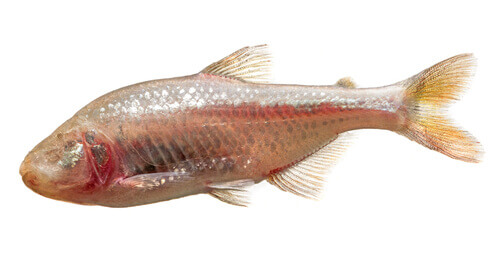Mexican Tetra Fish Repair Their Own Heart Tissue


Written and verified by the biologist Samuel Sanchez
Nature is full of fascinating processes that are often hard to believe. In fact, most animals have an arsenal of seemingly impossible survival tactics that involve regeneration, and some go as far as fully restoring lost limbs. Thus, evolution has allowed us to maximize our chances of reaching the next reproductive stage. For example, there’s a fish called the Mexican tetra which has the unique ability of being able to repair its own heart tissue.
This small, apparently fragile, fish hides secrets that even scientists haven’t been able to decipher. Indeed, they could be the answer to multiple heart pathologies in humans. Continue reading to learn more about this fascinating animal species.
Characteristics of the Mexican tetra fish
Before focusing our attention on its miraculous regenerative power, let’s describe this animal:
- The Astyanax mexicanus or Mexican tetra is a species of fish in the Characidae family belonging to the order of the Characiformes.
- There’s a marked sexual dimorphism: the females are larger and can reach up to 6 inches while the males only reach about 4 inches in diameter.
- This species has two very different morphological variants. One of them lives in rivers. Its appearance corresponds more to what we might imagine when we think of fish (grayish colors, a black dorsal line, dorsal and ventral fins) – nothing out of the ordinary, really.
- Then we also have the curious morphotype that lives in cave waters, in total darkness. They’ve undergone various changes in comparison to the other one. They’ve also lost their pigmentation and they look completely white. In addition, they have severe ocular degeneration, more maxillary teeth, more taste buds, etc. In short, they’ve adapted to a life without light.
This habitat differentiation, estimated to have happened over a million years ago, involves more essential evolutionary changes than mere bodily variation.

The secret of regeneration in Mexican tetra fish
The Mexican tetra is capable of regenerating its own heart tissue after severe damage to it. This fact is surprising on its own, but there’s more. (It turns out that depending on the morphotype, the regenerative capacity may be present or lost.)
- In a laboratory study conducted a few years ago, scientists discovered that the river morphotype can repair its heart, but the ones in caves can’t. Instead, the fish in the caves, even being of the same species, generated scar tissue.
- Analyzing these unusual response patterns, the researchers observed that two specific genes were exaggerated in the river morphotype after a heart injury. Without going into technicalities, these genes are called irrc10 and caveolin.
- The irrc10 gene also has regenerative capacities in other species, such as the zebrafish. By inhibiting the expression of these genes, this fish also largely lost their regenerative abilities.
- Reproductive crosses were also made between the river morphotype and the cave morphotype. The offspring presented different regenerative degrees, so they discovered that this is an inheritable ability.
These discoveries lead us to think that this gene may hold the secret to heart repair in the event of injury. The good news doesn’t end here though; this feature is also present in both mice and humans.
Knowledge and human health
So, what are scientists doing with all this knowledge?
It turns out that, in addition to the previously named gene, three other DNA regions were involved in the animal’s heart tissue regeneration process. Once this fascinating process has been broadly described, it’ll be time to fine-tune and detect the exact genes that differentiate simple scarring from full regeneration.
This type of research is essential to help us understand the world around us, but it can also have direct health benefits. Humans get much of their inspiration in the rest of the animal world. For example, our airplanes’ structures have a bird-like aerodynamic shape. So, it’s no wonder we also look to animals when it comes to looking for cures to common pathologies. Nature is wise and if we spend time trying to understand it, then we’re sure to come up with many beneficial solutions.
All cited sources were thoroughly reviewed by our team to ensure their quality, reliability, currency, and validity. The bibliography of this article was considered reliable and of academic or scientific accuracy.
-
Mexican tetra fish may offer heart repair clues, BBCnews. Recogido a 2 de mayo en https://www.bbc.com/news/health-46275178.
-
A Mexican cave fish may offer heart repair clues, UCL news. Recogido a 2 de mayo en https://www.ucl.ac.uk/news/2018/nov/mexican-cave-fish-may-offer-heart-repair-clues.
This text is provided for informational purposes only and does not replace consultation with a professional. If in doubt, consult your specialist.